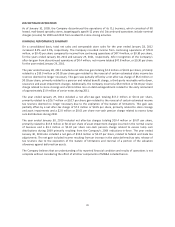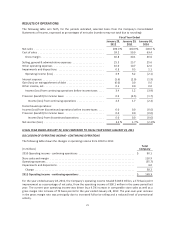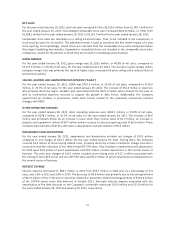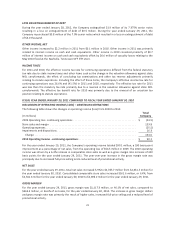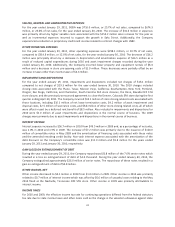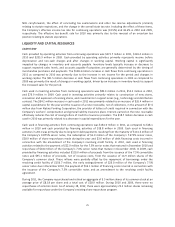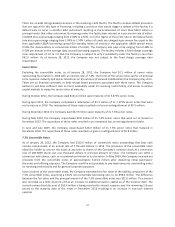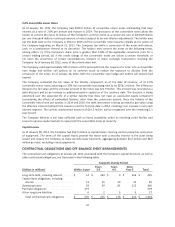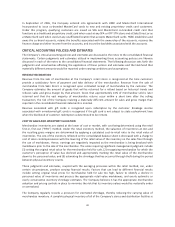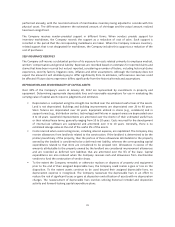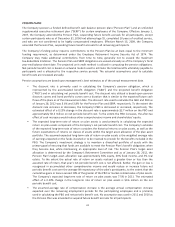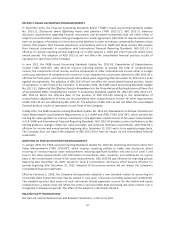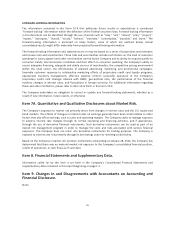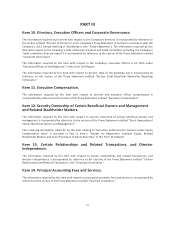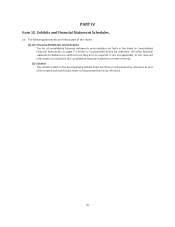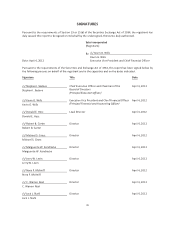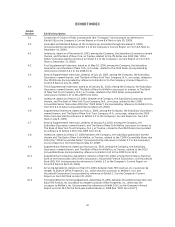Saks Fifth Avenue 2011 Annual Report Download - page 32
Download and view the complete annual report
Please find page 32 of the 2011 Saks Fifth Avenue annual report below. You can navigate through the pages in the report by either clicking on the pages listed below, or by using the keyword search tool below to find specific information within the annual report.In September of 2006, the Company entered into agreements with HSBC and MasterCard International
Incorporated to issue co-branded MasterCard cards to new and existing proprietary credit card customers.
Under this program, qualifying customers are issued an SFA and MasterCard co-branded credit card that
functions as a traditional proprietary credit card when used at any SFA or OFF 5TH store and at Saks Direct or as
a MasterCard card when used at any unaffiliated location that accepts MasterCard cards. HSBC establishes and
owns the co-brand accounts, retains the benefits associated with the ownership of the accounts, receives the
finance charge and other income from the accounts, and incurs the bad debts associated with the accounts.
CRITICAL ACCOUNTING POLICIES AND ESTIMATES
The Company’s critical accounting policies and estimates are discussed in the notes to the consolidated financial
statements. Certain judgments and estimates utilized in implementing these accounting policies are likewise
discussed in each of the notes to the consolidated financial statements. The following discussion sets forth the
judgments and uncertainties affecting the application of these policies and estimates and the likelihood that
materially different amounts would be reported under varying conditions and assumptions.
REVENUE RECOGNITION
Revenue from the sale of merchandise at the Company’s retail stores is recognized at the time customers
provide a satisfactory form of payment and take delivery of the merchandise. Revenue from the sale of
merchandise from Saks Direct is recognized upon estimated receipt of merchandise by the customer. The
Company estimates the amount of goods that will be returned for a refund based on historical trends and
reduces sales and gross margin by that amount. Given that approximately 22% of merchandise sold is later
returned and that the vast majority of merchandise returns occur within a short time after the selling
transaction, the risk of the Company realizing a materially different amount for sales and gross margin than
reported in the consolidated financial statements is minimal.
Revenue associated with gift cards is recognized upon redemption by the customer. Breakage income
associated with unredeemed gift cards is recognized if the gift card is not subject to state escheatment laws
when the likelihood of customer redemption is determined to be remote.
COST OF SALES AND INVENTORY VALUATION
Merchandise inventories are stated at the lower of cost or market, with cost being determined using the retail
first-in, first-out (“FIFO”) method. Under the retail inventory method, the valuation of inventories at cost and
the resulting gross margins are determined by applying a calculated cost-to-retail ratio to the retail value of
inventories. The cost of the inventory reflected on the consolidated balance sheet is decreased with a charge to
cost of sales contemporaneous with the lowering of the retail value of the inventory on the sales floor through
the use of markdowns. Hence, earnings are negatively impacted as the merchandise is being devalued with
markdowns prior to the sale of the merchandise. The areas requiring significant management judgment include
(1) setting the original retail value for the merchandise held for sale, (2) recognizing merchandise for which the
customer’s perception of value has declined and appropriately marking the retail value of the merchandise
down to the perceived value, and (3) estimating the shrinkage that has occurred through theft during the period
between physical inventory counts.
These judgments and estimates, coupled with the averaging processes within the retail method, can, under
certain circumstances, produce varying financial results. Factors that can lead to different financial results
include setting original retail prices for merchandise held for sale too high, failure to identify a decline in
perceived value of inventories and process the appropriate retail value markdowns, and overly optimistic or
overly conservative inventory shrinkage estimates. The Company believes it has the appropriate merchandise
valuation and pricing controls in place to minimize the risk that its inventory values would be materially under
or overvalued.
The Company regularly records a provision for estimated shrinkage, thereby reducing the carrying value of
merchandise inventory. A complete physical inventory of all of the Company’s stores and distribution facilities is
30


